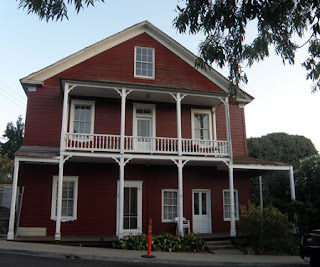California Landmark Number: 873
Team: Thing One, Thing Two
Date: September 30, 2012
Location:
Latitude:
N 36° 44.079
Longitude:
W 119° 47.484
Address: In planter, 100 ft SW of clock tower, Broadway and
Mariposa Mall, Fresno
It is amazing to us that in the turn the last century, Fresno was a hot bed of activism. This plaque commemorates the second fight for free speech by the Industrial Workers of the World, the first being in Spokane. In 1910, Police Chief Shaw started to crack down on public assembly of the workers union. This was done in conjunction with the local newspaper, the Fresno Morning Republican. On April 17th, an assembly was made, with a permit. A Mexican speaker spoke to the crowd and the police stopped the meeting because the Mexican was criticizing the police officials. A W.F. Little showed the assembly permit and continued the speaking. A news paper article tried to show how violent the IWW could become. A couple of days later, two vagrants, who were part of the IWW, was jailed. By June, the police chief had revoked all street-speaking permits. The IWW was notified that any talk against business interests is treason. The police also said they would arrest any man who refused a job. The summer time was a time of simmering tensions as the IWW waited until after harvest time to launch a strike, while officials claimed the IWW was an anarchist organization. By September, the IWW was refused a place in the Labor Day parade—the AFL was in the parade. As the Fall wore on, the IWW was mobilizing from all over the Nation to descend on Fresno to force the issue of can workers be organized. The tactics in Fresno by officials was to stifle the freedom of assembly and speech. By mid-October 250 men has descended into the IWW camp. The fight would boil and then die down for a month. Then in early December, on of the leaders was acquitted because there was no law stating he needed a permit to speak on the streets. A few days later a gang attacked the IWW camp, beating the workers and setting fire to the camp when the IWW tried to exercise their freedom of speech. This had the effect of being picked up the national news and more workers started coming to Fresno. It was reported that at times over 5,000 hobos and workers were streaming their way to Fresno. By this time, Fresno was tired and overwhelmed by the invasion and negotiated with the IWW. The effect was to allow free speech on the streets.
State of California Historical Resources
NO. 873 SITE OF THE FRESNO FREE SPEECH FIGHT OF THE INDUSTRIAL WORKERS OF THE WORLD - At the corner of Mariposa and I Streets, from October 1910 to March 1911, the Industrial Workers of the World fought for the right of free speech in their efforts to organize Fresno's unskilled labor force. This was the first fight for free speech in California, and the first attempt to organize the valley's unskilled workers.
Location: In planter, 100 ft SW of clock tower, Broadway and Mariposa Mall, Fresno
References:
- HOBO
ORATOR UNION, a dissertation by Matthew S May, July 2009
- Waymark
Overall Landmark References:
- David Schmitt's California
State Historical Landmark (Schmitt)
- Wikipedia: California's
National Landmarks (WCNL)
- State of California's California
Historical Landmarks (CHL)
- Wikipedia: California
State Landmarks (WCSL)
- State of California Historical
Resources (CHR)
- National
Registry of Historical Places (NRHP)
































